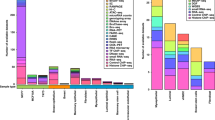Abstract
Alterations of the distal portion of the short arm of chromosome 1 (1p) are among the earliest abnormalities of human colorectal tumours. Recently, we have cloned the Aflatoxin B1 aldehyde reductase (AFAR) gene from a smallest region of overlapping deletion that is frequently (48%) hemizygously deleted in sporadic colorectal cancer. AFAR is expressed in a broad range of tissues. Its closely related rat protein is the major factor conferring resistance of rats towards aflatoxin B1–induced liver carcinogenesis. Here, we have identified cDNAs covering two additional human AFAR-related genes localized in close proximity to the previously described AFAR at 1p35–36. We have analysed their structure and tissue-related expression. One of them, AFAR3, carries a Selenocysteine-Insertion Element (SECIS)-like structure that during translation may recode an in-frame TGA-stop codon to a selenocysteine. Two additional AFAR-pseudogenes are localized at Xq25 and 1p12, respectively. AFAR exon sequences share an identity of DNA and amino acids of more than 78%. Also large blocks of intronic sequences can be up to 98.6% identical. Knowledge of the AFAR genes and their structure will be essential in genetic and functional studies, where discrimination of the genes and proteins is a prerequisite for evaluating their individual functions.
This is a preview of subscription content, access via your institution
Access options
Subscribe to this journal
Receive 50 print issues and online access
$259.00 per year
only $5.18 per issue
Buy this article
- Purchase on Springer Link
- Instant access to full article PDF
Prices may be subject to local taxes which are calculated during checkout




Similar content being viewed by others
References
Almeida RMA, Corrêa B, Xavier JG, Mallozzi MAB, Gambale W and Paula CR . (1996). Mycopathologia, 133, 23–29.
Berry MJ, Banu L, Chen YY, Mandel SJ, Kieffer JD, Harney JW and Larsen PR . (1991). Nature, 353, 273–276.
Cavalieri EL, Stack DE, Devanesan PD, Todorovic R, Dwivedy I, Higginbotham S, Johansson SL, Patil KD, Gross ML, Gooden JK, Ramanathan R and Cerny RL . (1997). Proc. Natl. Acad. Sci. USA, 94, 10937–10942.
Chen J, Goetchius MP, Campbell TC and Combs Jr GF . (1982). J. Nutr., 112, 324–331.
Clark LC and Alberts DS . (1995). J. Natl. Cancer Inst., 87, 473–475.
Corvi R, Amler LC, Savelyeva L, Gehring M and Schwab M . (1994). Proc. Natl. Acad. Sci. USA, 91, 5523–5527.
Ellis EM and Hayes JD . (1995). Biochem. J.not cited in the text pl. check, 312, 535–541.
Ellis EM, Judah DJ, Neal GE and Hayes JD . (1993). Proc. Natl. Acad. Sci. USA, 90, 10350–10354.
Garland M, Stampfer MJ, Willet WC and Hunter DJ . (1994). Frei B (ed.) Natural Antioxidants in Human Health and Disease. San Diego: Academic Press, pp. 263–286.
Gladyshev VN and Hatfield DL . (1999). J. Biomed. Sci., 6, 151–160.
Hengstler JG, van der Burg B, Steinberg P and Oesch F . (1999). Drug Metab. Rev., 31, 917–970.
Hinshelwood A, McGarvie G and Ellis E . (2002). FEBS Lett., 523, 213–218.
Houlston RS and Tomlinson IPM . (2000). J. Med. Genet., 37, 161–167.
Ireland LS, Harrison DJ, Neal GE and Hayes JD . (1998). Biochem. J., 332, 21–34.
Jez JM, Bennett MJ, Schlegel BP, Lewis M and Penning TM . (1997). Biochem. J., 326, 625–636.
Judah DJ, Hayes JD, Yang J-C, Lian L-Y, Roberts GCK, Farmer PB, Lamb JH and Neal GE . (1993). Biochem. J., 292, 13–18.
Kelly VP, Ireland LS, Ellis EM and Hayes JD . (2000). Biochem. J., 348, 389–400.
Kelly VP, Sherratt PJ, Crouch DH and Hayes JD . (2002). Biochem. J., 366, 847–861.
Knight LP, Primiano T, Groopman JD, Kensler TW and Sutter TR . (1999). Carcinogenesis, 20, 1215–1223.
Kozma E, Brown E, Ellis EM and Lapthorn AJ . (2002). J. Biol. Chem., 277, 16285–16293.
Low SC and Berry MJ . (1996). Trends Biochem. Sci., 21, 203–208.
Marnett LJ and Honn KV . (1994). Cancer Metastasis Rev., 13, 303–308.
McLeod R, Ellis EM, Arthur JR, Neal GE, Judah DJ, Manson MM and Hayes JD . (1997). Cancer Res., 57, 4257–4266.
Newberne PM and Butler WH . (1969). Cancer Res., 29, 236–250.
Nishi N, Shoji H, Miyanaka H and Nakamura T . (2000). Endocrinology, 141, 3194–3199.
Praml C, Finke LH, Herfarth C, Schlag P, Schwab M and Amler L . (1995). Oncogene, 11, 1357–1362.
Praml C, Savelyeva L, Perri P and Schwab M . (1998). Cancer Res., 58, 5014–5018.
Savelyeva L, Corvi R and Schwab M . (1994). Am. J. Hum. Genet., 55, 334–340.
Schaller M, Schaffhauser M, Sans N and Wermuth B . (1999). Eur. J. Biochem., 265, 1056–1060.
Schwab M, Praml C and Amler LC . (1996). Genes Chromosomes Cancer, 16, 211–229.
Senapathy P, Shapiro MB and Harris NL . (1990). Methods Enzymol., 183, 252–278.
Silver Key SC and Pagano JS . (1997). Virology, 234, 147–159.
Tudek B, Bird RP and Bruce WR . (1989). Cancer Res., 49, 1236–1240.
Zhu BT and Conney AH . (1998). Carcinogenesis (London), 19, 1–27.
Zuker M and Stiegler P . (1981). Nucleic Acids Res., 9, 133–148.
Acknowledgements
The Genbank Nucleotide Sequence Database Accession Numbers are AJ277796, AJ278012, AJ271883, AJ271800, AJ271801, AJ278012.
Author information
Authors and Affiliations
Corresponding author
Additional information
This study was supported by the Dr Mildred Scheel Stiftung.
Rights and permissions
About this article
Cite this article
Praml, C., Savelyeva, L. & Schwab, M. Aflatoxin B1 aldehyde reductase (AFAR) genes cluster at 1p35–1p36.1 in a region frequently altered in human tumour cells. Oncogene 22, 4765–4773 (2003). https://doi.org/10.1038/sj.onc.1206684
Published:
Issue Date:
DOI: https://doi.org/10.1038/sj.onc.1206684
Keywords
This article is cited by
-
Characterization and Analysis of Mammalian AKR7A Gene Promoters: Implications for Transcriptional Regulation
Biochemical Genetics (2020)
-
Proteomic Analysis of Differentially Expressed Proteins in Peripheral Cholangiocarcinoma
Cancer Microenvironment (2011)
-
Characterization of two aldo–keto reductases from Gluconobacter oxydans 621H capable of regio- and stereoselective α-ketocarbonyl reduction
Applied Microbiology and Biotechnology (2010)
-
Aldo-keto reductase (AKR) superfamily: Genomics and annotation
Human Genomics (2009)



